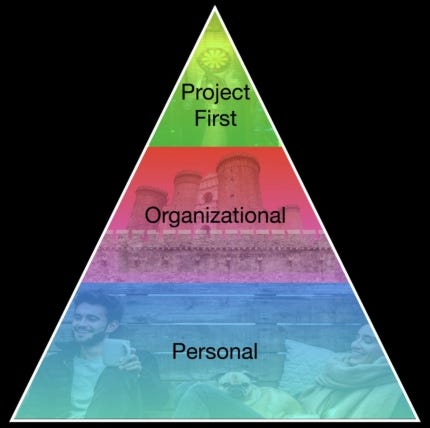Today’s Overview:
Projects are built by people. These people assemble into teams. Teams are networks of people making commitments to each other.
But most of the time, our teams aren't actually aligned. They have different needs, different personal goals; they have different moods and emotions. And essentially most people operate in their own self-interest.
I sat down with Dan Fauchier from Construction Accelerator and one of the leading voices behind Lean Alignment Partnering™, to talk through the Three Levels of Thinking, why traditional collaboration fails, and how to create Project First cultures that work.
🤝 Breaking Down Project Silos: The Three Levels of Thinking, & Cross-Departmental Collaboration
Filed under: Lean Tools & Tactics
Construction is a team sport. But most of the time, our teams aren't actually aligned.
Walk any jobsite, and you’ll see it:
Departments operate in silos.
Teams hoard information.
People protect their turf.
It’s not personal. It’s human.
Projects are built by people—and people, by nature, operate in their own self-interest. They have different goals, moods, needs, and incentives. But when you're trying to build a hospital, school, or stadium, you can’t afford to have a dozen different priorities pulling in different directions.
You need everyone thinking Project First.
So the question becomes:
How do we align individuals, departments, and companies to work together—collaboratively—for the success of the project?
I sat down with Dan Fauchier from Construction Accelerator and one of the leading voices behind Lean Alignment Partnering™, to talk through these exact ideas.
We break down the Three Levels of Thinking, why traditional collaboration fails, and how to create Project First cultures that work.
And it starts with how people think…
The Three Levels of Thinking on a Project
When it comes to collaboration, not all thinking is created equal. Most people are stuck in Level 1 or 2—focused on their own needs or their company’s interests. That’s not a bad thing. But it creates friction and inefficiency when the project is the one who pays the price.
To move past silos, you need a mental model—a way to elevate how people think on your project.
Let me introduce you to the Three Levels of Thinking:
Level 1: Personal Thinking
At Level 1, people are focused on personal safety—emotional safety, physical safety, and career safety. They want to protect their job, their reputation, their role. It’s human and necessary.
But when everyone is in self-preservation mode, collaboration suffers. People hide mistakes. They deflect blame. They withhold ideas that might make them look bad.
If someone doesn’t feel safe, they’ll never show up fully.
That’s why Level 1 is all about creating respectful environments. A project culture that acknowledges the needs of individuals. Only then can people rise to the next level.
Level 2: Team or Organizational Thinking
Level 2 thinking shifts the focus from me to we—but within company walls.
At this level, people align around business goals: profit, efficiency, repeat work. They want their company to succeed and are loyal to their internal team.
It’s a critical step. But it still creates conflict.
Why? Because Level 2 people fight for their company’s best interest—even if it’s at the project’s expense. Trade Partners optimize their scope. Designers dig in on details. Contractors push risk downstream.
Everyone’s rowing, but not in the same direction.
That’s why we need…
Level 3: Project First Thinking
This is the highest level of thinking—and where true collaboration lives.
At Level 3, people make decisions based on what’s best for the project, not just themselves or their employer.
You only get to this level when people feel safe (Level 1) and have strong team identity (Level 2).
So how do you get to level 3? You have to START at Level 3. You commit to Level 3 thinking. When we make a decision, we will choose what’s best for the whole project.…
This is where Lean thrives.
This is where trust is built.
This is where world-class projects are delivered.
Lean Alignment Partnering™ - A System for Getting There
If Level 3 Thinking is the goal, then Lean Alignment Partnering™ is the operating system.
It’s a facilitated process that creates a neutral space for owners, contractors, designers, and subs to come together—early, openly, and repeatedly.
Unlike traditional kickoff meetings that check boxes and breed politeness, Lean Partnering surfaces real issues. It encourages vulnerability. It reframes challenges as shared problems to solve—not games to win.
The result?
People speak candidly. Teams organize horizontally by role and responsibility—not vertically by company hierarchy. Project managers from different firms collaborate directly instead of sending messages up and down the org chart. Superintendents share real jobsite risks and solutions—not filtered reports.
At the top, Executive Teams from each company meet to align on major decisions and stay accountable to project outcomes—not corporate politics.
It’s a total shift—from compliance to commitment.
Why Silos Persist—and How to Break Them
Most communication on jobs today looks like this:
Company A → Department → Manager → Company B → Manager → Department → PersonThat’s a game of telephone, not a team.
Important issues are filtered, delayed, or distorted as they travel
through the chain.
Worse, they often get politicized.
Lean Partnering fixes this by aligning communication structures to the project, not the company. You go direct, not up. You collaborate horizontally, not vertically.
This isn’t fluffy idealism—it’s pragmatic project management.
It’s how you get ahead of risks, move faster, and reduce rework.
Final Thoughts
Getting people to Level 3 Thinking isn’t easy. You have to earn it.
You have to create safety at every level of your org chart. You have to model transparency. You have to invite hard conversations. You have to say “Project First” and mean it—even when it costs you something.
But when you do, things start to click:
Information flows.
Trust grows.
Decisions speed up.
Projects get done better, faster, and with fewer surprises.
And once you experience it, you’ll never go back.
Until next week,
Kyle Nitchen

Whenever you're ready, there are 5 ways I can help you:
Get my first book! No Bullsh*t Project: A Project Manager’s Guide to Successful Project Leadership
Upgrade your scheduling software. Experience the future planning system for construction and real estate development. iPM subscribers get a 15% discount on the first year license.
Get my full toolbox (free). Access 30+ software and hardware tools I'm using today.
Learn Takt Planning. Elevate your skills as a scheduler, planner, and lean builder with the Takt Planning & Control online course. Use code "Influentialpmtakt" for 30% off.
Advertise in my newsletter. Put your brand in front of 7,000+ construction project managers, leaders, and execs. (Booked out 8 weeks)















